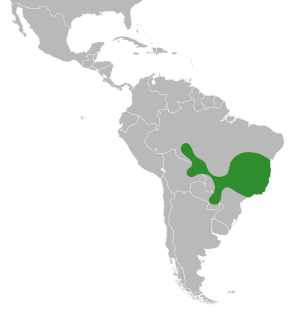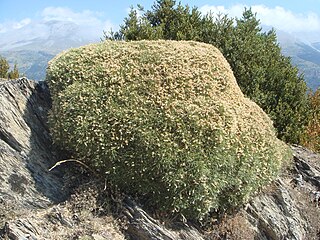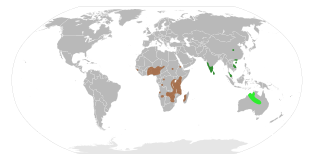
Styphnolobium is a small genus of three or four species of small trees and shrubs in the subfamily Faboideae of the pea family Fabaceae, formerly included within a broader interpretation of the genus Sophora. It was recently assigned to the unranked, monophyletic Cladrastis clade. They differ from the genus Calia (mescalbeans) in having deciduous leaves and flowers in axillary, not terminal, racemes. The leaves are pinnate, with 9–21 leaflets, and the flowers in pendulous racemes similar to those of the black locust. Necklacepod is a common name for plants in this genus.

Camoensia is a genus of 2 species of lianas in the family Fabaceae, subfamily Faboideae, native to the Gulf of Guinea, Africa. C. scandens is cultivated as an ornamental plant; it has one of the largest leguminous flowers, up to 20 cm across. The genus has classically been assigned to the tribe Sophoreae, but was recently assigned to its own monophyletic tribe, Camoensieae, on the basis of molecular phylogenetic evidence. Species of Camoensia are known to produce quinolizidine alkaloids, consistent with their placement in the genistoid clade.

Calpurnia is a genus of flowering plants within the family Fabaceae. The genus comprises shrubs or small trees in or along the margin of forests in the eastern parts of South Africa. They shed leaves in winter unless in moist areas, where they are evergreen. They make good garden plants because they are easily raised from seed, flower at two years and withstand frost.

Cladrastis (yellowwood) is a genus of nine species of flowering plants in the family Fabaceae, eight native to eastern Asia, and one to southeastern North America.

Baphia is a small genus of legumes that bear simple leaves. Baphia is from the Greek word βάπτω, referring to a red dye that is extracted from the heartwood of tropical species. The genus is restricted to the African tropics. Baphia was traditionally assigned to the tribe Sophoreae; however, recent molecular phylogenetic analyses reassigned Baphia to the tribe Baphieae.

Amphimas is a small genus of flowering plants in the legume family, Fabaceae. It belongs to the subfamily Faboideae. It is a west African tree used for medicine and for wood. Amphimas was traditionally assigned to the tribe Sophoreae; however, recent molecular phylogenetic analyses reassigned Amphimas into an unspecified position in the Meso-Papilionoideae.
Baphiopsis parviflora is an African species of flowering plants in the legume family, Fabaceae. It belongs to the subfamily Faboideae. It is the only member of the genus Baphiopsis. It was traditionally assigned to the tribe Swartzieae; however, recent molecular phylogenetic analyses reassigned Baphiopsis parviflora into the Baphieae tribe.

Cyclolobium brasiliense is a species of flowering plants in the legume family, Fabaceae. It belongs to the subfamily Faboideae. It is native to Bolivia, Brazil, and Paraguay and is the only member of the genus Cyclolobium.
Dalhousiea is a genus of flowering plants in the legume family, Fabaceae. It belongs to the subfamily Faboideae. It was named after Christian Ramsay, Countess of Dalhousie, by Robert Graham for her work in the classification of Indian botany. Dalhousiea was traditionally assigned to the tribe Sophoreae; however, recent molecular phylogenetic analyses reassigned Dalhousiea into the Baphieae tribe.

Echinospartum is a genus of flowering plants in the legume family, Fabaceae. It belongs to the subfamily Faboideae. It is possibly synonymous with Genista.

Hymenolobium is a genus of flowering plants in the legume family, Fabaceae. It belongs to the subfamily Faboideae. It was formerly assigned to the tribe Dalbergieae, but recent molecular phylogenetic evidence has placed it in a unique clade named the Andira clade.

Hypocalyptus is a genus of flowering plants in the legume family, Fabaceae. It belongs to the subfamily Faboideae and is the only genus found in Tribe Hypocalypteae.
Leucomphalos is a genus of flowering plants in the legume family, found in west Africa. It belongs to the subfamily Faboideae. Leucomphalos was traditionally assigned to the tribe Sophoreae; however, recent molecular phylogenetic analyses reassigned Leucomphalos to the Baphieae tribe.
Myrospermum frutescens, the cercipo, is a species of flowering plant in the legume family, Fabaceae. It belongs to the subfamily Faboideae. It is the only member of the genus Myrospermum.

Stauracanthus is a genus of flowering plants in the legume family, Fabaceae. It belongs to the subfamily Faboideae. It is sometimes treated as part of the genera Genista or Ulex.

Vavilovia formosa is a species of flowering plants in the legume family, Fabaceae. It belongs to the subfamily Faboideae. It is the only member of the genus Vavilovia. It was named after the Russian geneticist, economic botanist, and plant geographer, Nikolai Ivanovich Vavilov. It is found primarily in high mountain areas on shale or rocky ground in Turkey, Iran, Iraq, and Lebanon.

Rothia is a genus of flowering plants in the legume family, Fabaceae. It belongs to the tribe Crotalarieae of subfamily Faboideae, and comprises two species:
Amphiodon effusus is a species of legume in the subfamily Faboideae. It is found in non-flooded areas of the Amazon rainforest. It is the only member of the genus Amphiodon.
Baphiastrum is a genus of flowering plants in the legume family, found in west Africa. It belongs to the subfamily Faboideae. Baphiastrum was traditionally assigned to the tribe Sophoreae; however, recent molecular phylogenetic analyses reassigned Baphiastrum to the Baphieae tribe.
Bowringia is a genus of flowering plants in the legume family, found in west Africa. It belongs to the subfamily Faboideae. It was named after Sir John Bowring and his son, J. C. Bowring for their botanical work in China. Bowringia was traditionally assigned to the tribe Sophoreae; however, recent molecular phylogenetic analyses reassigned Bowringia to the Baphieae tribe.














